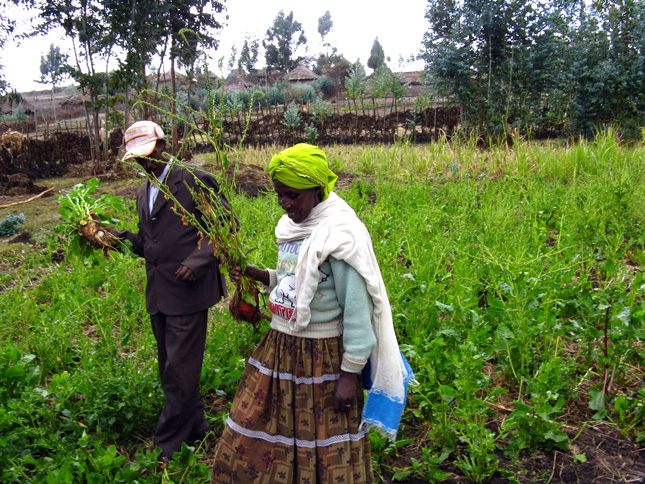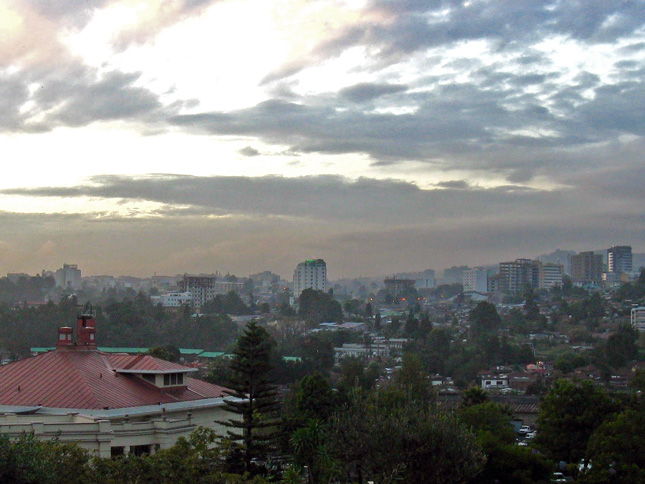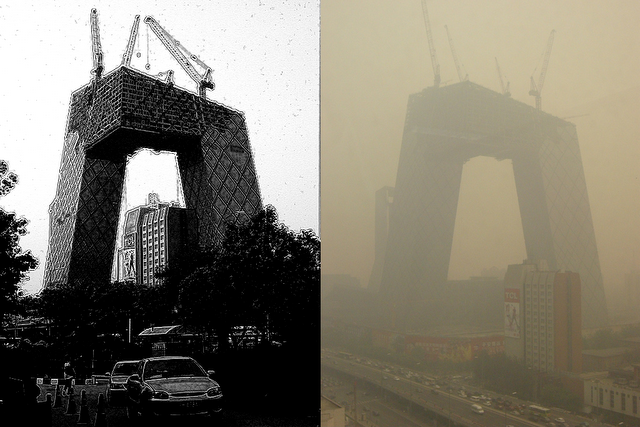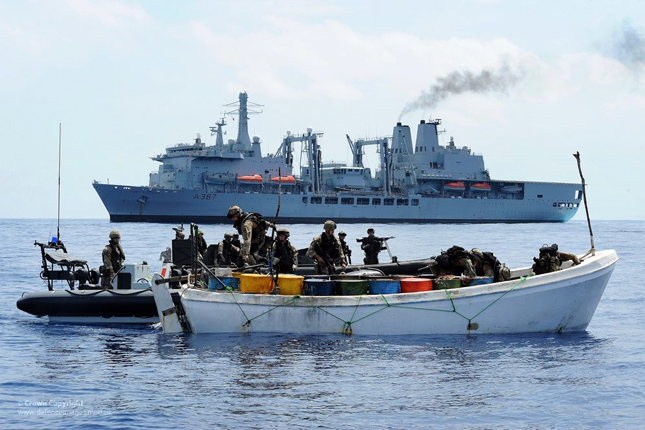-
The Impact of Environmental Change and Geography on Conflict
›“Environmental Change, Strategic Foresight, and Impacts on Military Power,” published in Parameters by Chad M. Briggs, the Minerva Chair of Energy and Environmental Security at the Air University, USAF, tackles the changing definition of “environmental security” and how the concept can help planners better prepare for the effects of climate change and an elevated focus on energy security. New potentially destabilizing issues like glacial melt, sea-level rise, and Arctic ice melt are on the horizon, writes Briggs. China and others are already planning for these events, and it’s important that the United States does the same, starting with a greater appreciation for the impact of environmental security on vulnerability and risk. “Due to past practices and bureaucratic stovepipes, implementation is limited more by initiative and imagination than actual resources,” he writes.
Clionadh Raleigh of Trinity College Dublin and the International Peace Research Institute finds in “Seeing the Forest for the Trees: Does Physical Geography Affect a State’s Conflict Risk?” that a region’s geography does not have a uniform effect on its likelihood of experiencing conflict. Raleigh’s conclusions, published in International Interactions, run counter to traditional histories which often emphasize the importance of physical geography, specifically with regard to civil war and insurgencies. Focusing on the Great Lakes region of Africa, Raleigh finds that other factors – like how populated an area is and its proximity to valuable natural resources – correlate higher with an area’s propensity for violence than any other factor. -
Integrated Approach Helps “Model Farmers” Increase Productivity in Ethiopia
›March 24, 2011 // By Schuyler Null
To reach the village of Grar Gaber from Addis Ababa, you drive up over the Entoto Mountains overlooking the capital then motor down two hours of new Japanese-built highway to the town of Fiche. From there it’s 20 minutes on a broken dirt road across rocky hills. I was joined there by about 20 others from the PHE Ethiopia Consortium’s general assembly (see day one and day two coverage here) and Population Action International, to visit an integrated population, health, and environment (PHE) development program run by LEM Ethiopia.
-
“Better Bang for the Buck”: Blogging From Ethiopia’s Population, Health, and Environment General Assembly
›March 18, 2011 // By Schuyler Null
Hello from Addis Ababa, where I am blogging from the 5th annual general assembly of the Population, Health, and Environment (PHE) Consortium of Ethiopia (see further coverage here). Along with the Philippines, Ethiopia is the largest PHE programmer in the world, both in terms of number of programs and people affected, and for good reason: The country combines dire need, willing donors, and a great deal of local capacity and will.
-
Hu Angang and Liang Jiaochen, ChinaDialogue
China’s Green Five-Year Plan: Making “Ecological Security” a National Strategy
›March 16, 2011 // By Wilson Center StaffThe original version of this article, by Hu Angang and Liang Jiaochen, appeared on ChinaDialogue.
Five-year plans (FYPs), which set down and clarify national strategy, are one of China’s most important policy tools. Just as they have helped to drive China’s economic success over recent decades, so they will play a pivotal role in putting the country on a green development path. The 12th Five-Year Plan, now under consideration by the National People’s Congress, marks the beginning of that process in earnest (Editor’s note: Since this was originally published, the National People’s Congress voted in favor of the plan).
FYPs embody the concept of progressing by degrees, or developing step by step. This approach has been one of the driving forces behind China’s economic progress in recent decades and will now provide the platform for its green development. It is the methodology underpinning China’s socialist modernization: to reach a new step in development every five years. Unstinting efforts over a number of FYPs have driven China’s transformation.
Climate change presents a long-term and all-encompassing challenge for China. It demands a long-term development strategy and broad goals, as well as near-term action plans and concrete policies. Combining these is precisely the idea behind FYPs.
At the global climate change summit in Copenhagen in 2009, China demonstrated it has the long-term political will to respond to climate change; to work with the world to limit global temperatures to no more than two degrees Celsius above pre-industrial temperatures (the goal set out in the Copenhagen Accord). In November that year, the Chinese government formally put forward its medium-term targets on climate change: a reduction in energy intensity of 40 percent to 45 percent on 2005 levels by 2020, and generation of 15 percent of energy from non-fossil fuel sources by the same date.
Continue reading on ChinaDialogue.
Hu Angang is a professor at the Chinese Academy of Sciences and Tsinghua University and the director of the Centre for China Study. He has worked as the chief editor for China Studies Report, a circulated reference for senior officials. Liang Jiaochen is a PhD student at Tsinghua University’s School of Public Policy and Management.
Sources: Business Green, UN Framework Convention on Climate Change, World Resources Institute.
Photo Credit: Adapted from “China: CREME,” courtesy of flickr user IFC Infrastructure (Alejandro Perez/IFC). -
Shannon Beebe, Los Angeles Times
Somali Piracy Shows How an Environmental Issue Can Evolve Into a Security Crisis
›March 14, 2011 // By Wilson Center Staff
It has become apparent that real piracy is far different from the lighthearted subject sometimes portrayed in popular culture, and the problem is growing much worse. Besides the tragic cost in lives, the United States, many other nations, and NATO spent roughly $2 billion combined last year to safeguard the busy international sea lanes off the Horn of Africa from Somali pirates. According to the International Maritime Bureau, “hijackings off the coast of Somalia accounted for 92 percent of all ship seizures last year,” and the price tag does not include the costs of reallocating critical military resources.
-
Managing the Planet’s Freshwater
›“The impact of human activities on the planet and on its biology has risen to a scale that deserves a commensurate response,” said Tom Lovejoy, professor at George Mason University, introducing a discussion on “Managing the Planet’s Freshwater,” the second of a monthly series led jointly by George Mason University and the Woodrow Wilson Center. Karin M. Krchnak, director of International Water Policy at The Nature Conservancy (TNC), and Dann Sklarew, sustainability fellow at George Mason University, joined Lovejoy to discuss the increasing stress placed by population growth, urbanization, and environmental change on freshwater resources and potential solutions to global water insecurity. [Video Below]
Water: “A Global Crisis”
Water insecurity and pollution is “a global crisis,” said Sklarew. Water scarcity is growing and aquatic biodiversity is declining around the world. According to the World Water Council, over one billion people do not have safe drinking water.
Inadequate water management contributes to these problems, said Sklarew. But, human activities “impact water connectivity, quality, and flows” at all scales, he said, and combined with climate change, have fundamentally altered the global water cycle.
“The water-rich and the water-poor are intimately connected,” said Sklarew. National, international, and global trade “water transfers” often move water from dry rural areas to urban centers, he said. “We’re taking from areas that don’t have [water] and moving water, by itself or via food products, to places where they might actually have more water in their local environment.”
But there are many opportunities – from the incremental to the bold, exciting, and revolutionary – to address these problems, said Sklarew, including growing more food with less water, reducing destructive subsidies, restoring natural river flows via dam re-design or removal, encouraging greener infrastructure in urban areas, and supporting participatory decision-making about water. He also pointed to promoting lower population growth and allowing migration that “brings the people to the water rather than the water to the people” as additional ways to improve water security. In the future, “bio-mimicking and techno-fixes,” may also provide promising solutions, he said.
Clear national goals and a global-scale response are critical to making these solutions a reality, said Sklarew: “Even though these challenges are often local, in the end, we have one interconnected water system.”
Watershed Protection: Innovative Solutions
“I know we all wish that there was a silver bullet for global water challenges,” said Krchnak, “but there’s not just one solution.”
As population grows by an additional 2 billion people before 2050, “solutions must take population growth into account,” said Krchnak. One-third of the world’s population is now subject to water scarcity, which is expected to double in the next 30 years
More water will be necessary to meet growing demands for food, energy, and other commodities, said Krchnak. In particular, “the poor in urban centers will be the dominant challenge for us in the next decades.”
Krchnak described three possible strategies to protect watersheds: market-based mechanisms, integrated water resource management, and incentive approaches.
Water funds, a market-based mechanism in which downstream water users pay for protection of the upper watershed, are one possible way to better manage freshwater, said Krchnak. With the help of local partners, TNC’s Quito Water Fund, for example, creates a sustainable finance mechanism and protects watersheds that supply 2 million people. Similar programs “can be taken to other geographies and replicated across the globe,” she said.
Another TNC program, the Great River Partnership, uses an integrated water resource management strategy that focuses on stakeholder collaboration and working with public and private partners to help create “one vision” for major rivers like the Mississippi, Magdalena, Paraguay-Parana, Yangtze, and Zambezi, said Krchnak.
The Alliance for Water Stewardship uses an incentive-based approach to promote “responsible use of fresh water that is socially beneficial and environmentally and economically sustainable.” One of the main objectives of the Alliance is to develop performance standards and create a certification program that recognizes water providers who work to protect freshwater resources.
Strategies like these may not be appropriate everywhere, and programs need to be adapted to make local implementation possible, said Krchnak, but effectively managing the planet’s freshwater is vital for human health, spiritual and cultural well-being, ecosystems and biodiversity, and economic opportunity.
Sources: World Water Council, UNDP.
Photo Credit: “Rio Magdalena,” courtesy of flickr user Esparta. -
Carrying Capacity: Should We Be Aiming to Survive or Flourish?
›“In the eyes of many governments, population has, as we all know, been a rather uncomfortable topic for a number of years,” said Nobel Laureate Sir John Sulston, FRS, chair of the Institute for Science, Ethics, and Innovation at the University of Manchester and chair of the Royal Society’s People and the Planet working group. At an event at the Wilson Center on February 22, Sulston and his co-panelists, Martha Campbell, president of Venture Strategies for Health and Development, and Professor Parfait Eloundou-Enyegue of Cornell University, encouraged active debate on a range of population dynamics and their connections to economic, environmental, and political futures. [Video Below]
The Nexus of Population and Consumption
The dialogue between population and environmental communities has been pushed aside for many years but has lately been climbing its way back onto national agendas, said Sulston. However, the debate remains polarized. Scientists need to “sort out the facts as best we can” to help bring the communities together, he said. The Royal Society’s People and the Planet study, which will be completed by early 2012, will “provide policy guidance to decision-makers as far as possible” and “play our part in engendering constructive dialogue,” he said.
“What we should be aiming to do is to ensure that every individual on the planet can come to enjoy the same high quality of life whilst living within the Earth’s natural limits,” said Sulston. Instead of talking about the maximum number of people the Earth can hold, we should also focus on “the quality of life of those people,” he said. People are happier, healthier, and wealthier than ever before, according to human development indexes. But, Sulston said, 200 million women worldwide have an unmet need for family planning, ecosystems are degraded, biodiversity has decreased, and there are widespread shortages of food and water.
For centuries humanity has pursued a policy of “competitive growth,” both in population and consumption. But in preparation for the UN “Rio+20” summit on sustainable development in 2012, policymakers should be discussing “pathways to sustainability within the context of population,” said Sulston.
“Humanity needs to learn to act collectively and constructively in the face of these long-term and therefore rather elusive threats, just as we do rather well when we’re faced with immediate and tangible ones,” Sulston said. “So we need the best technology, but we need it in the context of a thoughtful society, and then we can both survive and happily flourish.”
A Demographic Crossroads
“No longer is population growth or population size the only issue of the day,” said Parfait Eloundou-Enyegue. “You have to worry about both population growth and population decline, you have to worry about immigration, you have to worry about aging, you have to worry about HIV and adult mortality, et cetera.”
Some people, Eloundou-Enyegue said, take this diversity of demographic issues as “grounds for complacency” by thinking they do not share in others’ problems. Yet, he said, population and ecology are areas where the risks are shared by all.
These challenges demand a “more comprehensive framework” that details the interactions between population, affluence, environment, technology, and inequality, said Eloundou-Enyegue. Tensions persist between these different areas, and breaking them will require “call[ing] on other qualities of the human spirit,” he said. The world is, Eloundou-Enyegue concluded, at a “demographic crossroads.”
The Timing of Declining Fertility
The key to ending the sensitivity to the issue of population growth is to “understand that this is about options: options for women and options for families,” said Martha Campbell. Strong attention and funding support can meet needs and lead to declining birth rates, as in the case of Kenya before the mid-1990s. But with the broader emphasis on reproductive health and concerns about coercion that followed the 1994 United Nations International Conference on Population and Development (ICPD) in Cairo, funding for family planning declined. As a result, Kenya’s fertility rates leveled off instead of continuing to decline, said Campbell, contributing to an upward revision of global population projections.
Campbell illustrated the impact of delays in achieving replacement-level fertility on the overall population size of individual states. In the case of Pakistan, for example, analysis by Venture Strategies for Health and Development and the African Institute for Development Policy projects that the country will have a total population of 350 million if replacement-level fertility is reached by 2020, and a population of almost 600 million if that same mark is reached by 2060.
Looking ahead to the “Rio+20” summit in 2012, Campbell emphasized the need for continued discussion about population growth and family planning. The silence on these issues after Cairo in 1994 and the subsequent global impact should serve as a warning for future generations, she said: “It is important for this next generation and the current generation to understand what happened so that it will never, ever happen again. The silence on population must not occur.”
Photo Credit: “Rush hour,” courtesy of flickr user Jekkone, and Pakistan fertility chart, courtesy of Martha Campbell and Venture Strategies. -
Watch: Sir John Sulston on the Royal Society’s People and the Planet Study
›March 1, 2011 // By Christina Daggett“At the moment, the agendas of the growing population of people and the environment are too separate – people are thinking about one or the other,” said Sir John Sulston, Nobel laureate and chair of the Royal Society’s People and the Planet working group, in an interview with ECSP. “People argue about, ‘Should we consume less or should we have fewer people?’ The point is it’s both. We need to draw it together. It’s people and their activities.”
Sulston won the 2002 Nobel Prize in Physiology or Medicine for his work on mapping the human genome. He said that experience helped him appreciate the importance of utilizing science to the benefit of the wider public as he advocated for keeping the human genome in the public domain rather than allowing the knowledge to be privatized.
Sulston spoke at the Wilson Center on Febraury 22 on carrying capacity and the Royal Society’s People and the Planet study. He said “what we want to do is to see the issue of population in the open, dispassionately discussed on the environmental agenda, and then we’ll see where it goes.” The study will “draw together the strands, to summarize, and to put it down as a statement of the state of the art of our knowledge and where it’s going.” The study will be released in early 2012 with an eye to informing the UN “Rio+20” conference on sustainable development.
“We have one planet,” Sulston said, and “we have a lot of people, an increasing number of people. Now it’s not straightforward…but I think if you look at the facts dispassionately, you find that actually, because of our sheer numbers and because of our activities, the combination of those two things mean that we are putting an increasing burden on the planet and I think it is something we have to start thinking about.”
Showing posts from category environment.












